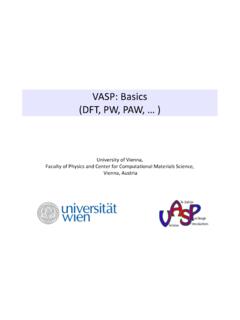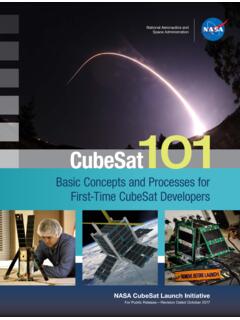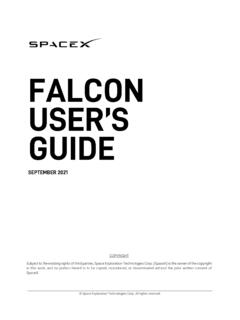Transcription of OpenCL: A Hands-on Introduction - NERSC
1 OpenCL: A Hands-on Introduction Tim Mattson Intel Corp. Alice Koniges Berkeley Lab/ NERSC Simon McIntosh-Smith University of Bristol Acknowledgements: In addition to Tim, Alice and Simon .. Tom Deakin (Bristol) and Ben Gaster (Qualcomm) contributed to this content. Agenda Lectures Exercises An Introduction to OpenCL Logging in and running the Vadd program Understanding Host programs Chaining Vadd kernels together Kernel programs The D = A + B + C problem Writing Kernel Programs Matrix Multiplication Lunch Working with the OpenCL memory model Several ways to Optimize matrix multiplication High Performance OpenCL Matrix multiplication optimization contest The OpenCL Zoo Run your OpenCL programs on a variety of systems. Closing Comments Course materials In addition to these slides, C++ API header files, a set of exercises, and solutions, we provide: OpenCL C Reference Card OpenCL C++ Reference Card These cards will help you keep track of the API as you do the exercises: The spec is also very readable and recommended to have on-hand.
2 AN Introduction TO OPENCL Industry Standards for Programming Heterogeneous Platforms OpenCL Open Computing Language Open, royalty-free standard for portable, parallel programming of heterogeneous parallel computing CPUs, GPUs, and other processors CPUs Multiple cores driving performance increases GPUs Increasingly general purpose data-parallel computing Graphics APIs and Shading Languages Multi-processor programming OpenMP Emerging Intersection Heterogeneous Computing The origins of OpenCL AMD AT I NVIDIA Intel Apple Merged, needed commonality across products GPU vendor wants to steal market share from CPU CPU vendor wants to steal market share from GPU Was tired of recoding for many core, GPUs. Pushed vendors to standardize. Wrote a rough draft straw man API Khronos Compute group formed ARM Nokia IBM Sony Qualcomm Imagination TI Third party names are the property of their owners.
3 + many more OpenCL: From cell phone to supercomputer OpenCL Embedded profile for mobile and embedded silicon Relaxes some data type and precision requirements Avoids the need for a separate ES specification Khronos APIs provide computing support for imaging & graphics Enabling advanced applications in, , Augmented Reality OpenCL will enable parallel computing in new markets Mobile phones, cars, avionics A camera phone with GPS processes images to recognize buildings and landmarks and provides relevant data from internet OpenCL Platform Model One Host and one or more OpenCL Devices Each OpenCL Device is composed of one or more Compute Units Each Compute Unit is divided into one or more Processing Elements Memory divided into host memory and device memory Processing Element OpenCL Device.
4 Host Compute Unit The BIG idea behind OpenCL Replace loops with functions (a kernel) executing at each point in a problem domain , process a 1024x1024 image with one kernel invocation per pixel or 1024x1024=1,048,576 kernel executions Tr a d i t i o n a l l o o p s OpenCL void !mul(const int n,! const float *a,! const float *b,! float *c)!{! int i;! for (i = 0; i < n; i++)! c[i] = a[i] * b[i];!}!__kernel void!mul(__global const float *a,! __global const float *b,! __global float *c)!{! int id = get_global_id(0);! c[id] = a[id] * b[id];!}!// execute over n work-items!An N-dimensional domain of work-items Global Dimensions: 1024x1024 (whole problem space) Local Dimensions: 128x128 (work-group, executes together) Choose the dimensions (1, 2, or 3) that are best for your algorithm 1024 1024 Synchronization between work-items possible only within work-groups: barriers and memory fences Cannot synchronize between work-groups within a kernel OpenCL Memory model Private Memory Per work-item Local Memory Shared within a work-group Global Memory Constant Memory Visible to all work-groups Host memory On the CPU Memory management is explicit: You are responsible for moving data from host global local and back Context and Command-Queues Context.
5 The environment within which kernels execute and in which synchronization and memory management is defined. The context includes: One or more devices Device memory One or more command-queues All commands for a device (kernel execution, synchronization, and memory operations) are submitted through a command-queue. Each command-queue points to a single device within a context. Queue Context Device Device Memory Execution model (kernels) OpenCL execution model .. define a problem domain and execute an instance of a kernel for each point in the domain __kernel void times_two(! __global float* input,! __global float* output)!{! int i = get_global_id(0);! output[i] = * input[i];!}!get_global_id(0)!10 Input Output 0 1 2 3 4 5 6 7 8 9 10 11 12 13 14 15 16 17 18 19 20 21 22 23 24 25 0 2 4 6 8 10 12 14 16 18 20 22 24 26 28 30 32 34 36 38 40 42 44 46 48 50 __kernel void !
6 Horizontal_reflect(read_only image2d_t src,! write_only image2d_t dst) !{! int x = get_global_id(0); // x-coord ! int y = get_global_id(1); // y-coord ! int width = get_image_width(src); ! float4 src_val = read_imagef(src, sampler, ! (int2)(width-1-x, y)); ! write_imagef(dst, (int2)(x, y), src_val);!}!Building Program Objects The program object encapsulates: A context The program source or binary, and List of target devices and build options The build process to create a program object: OpenCL uses runtime compilation .. because in general you don t know the details of the target device when you ship the program Compile for GPU Compile for CPU GPU code CPU code cl::Program program(context, KernelSource, true);!Example: vector addition The hello world program of data parallel programming is a program to add two vectors C[i] = A[i] + B[i] for i=0 to N-1!
7 For the OpenCL solution, there are two parts Kernel code Host code Vector Addition - Kernel __kernel void vadd( !!!! __global const float *a,!!!! __global const float *b,!!!! __global float *c)! {! int gid = get_global_id(0);! c[gid] = a[gid] + b[gid];! }!!Exercise 1: Running the Vector Add kernel Goal: To i n s p e c t a n d v e r i f y t h a t y o u c a n r u n a n O p e n C L k e r n e l Procedure: Ta k e t h e Vadd program we provide you. It will run a simple kernel to add two vectors together. Look at the host code and identify the API calls in the host code. Compare them against the API descriptions on the OpenCL C++ reference card. Expected output: A message verifying that the program completed successfully 1. ssh -X (and enter supplied password) 2.
8 Ssh -X dirac# (and enter supplied password) 3. cp -r /projects/projectdirs/training/SC14/Open CL_exercises/ . 4. module unload pgi openmpi cuda 5. module load gcc-sl6 6. module load openmpi-gcc-sl6 7. module load cuda 8. cd OpenCL_exercises 9. cp Make_def_ 8. cd /Exercises/Exercise01 9. make; ./vadd (etc) More: UNDERSTANDING THE HOST PROGRAM Vector Addition Host The host program is the code that runs on the host to: Setup the environment for the OpenCL program Create and manage kernels 5 simple steps in a basic host program: 1. Define the platform .. platform = devices+context+queues 2. Create and Build the program (dynamic library for kernels) 3. Setup memory objects 4. Define the kernel (attach arguments to kernel function) 5. Submit commands .. transfer memory objects and execute kernels Have a copy of the vadd host program on hand as we go over this set of slides.
9 The C++ Interface Khronos has defined a common C++ header file containing a high level interface to OpenCL, This interface is dramatically easier to work with1 Key features: Uses common defaults for the platform and command-queue, saving the programmer from extra coding for the most common use cases Simplifies the basic API by bundling key parameters with the objects rather than requiring verbose and repetitive argument lists Ability to call a kernel from the host, like a regular function Error checking can be performed with C++ exceptions 1 especially for C++ C++ Interface: setting up the host program Enable OpenCL API Exceptions. #define __CL_ENABLE_EXCEPTIONS! Include key header files .. both standard and custom #include < > // Khronos C++ Wrapper API!#include <cstdio> // C style IO ( printf)!
10 #include <iostream> // C++ style IO!#include <vector> // C++ vector types!For information about C++, see the appendix C++ for C programmers . Do this before including the header files 1. Create a context and queue Grab a context using a device type: cl::Context context(CL_DEVICE_TYPE_DEFAULT);!! Create a command queue for the first device in the context: cl::CommandQueue queue(context);!Commands and Command-Queues Commands include: Kernel executions Memory object management Synchronization The only way to submit commands to a device is through a command-queue. Each command-queue points to a single device within a context. Multiple command-queues can feed a single device. Used to define independent streams of commands that don t require synchronization Queue Queue Context GPU CPU Command-Queue execution details Command queues can be configured in different ways to control how commands execute In-order queues: Commands are enqueued and complete in the order they appear in the host program (program-order) Out-of-order queues: Commands are enqueued in program-order but can execute (and hence complete) in any order.










